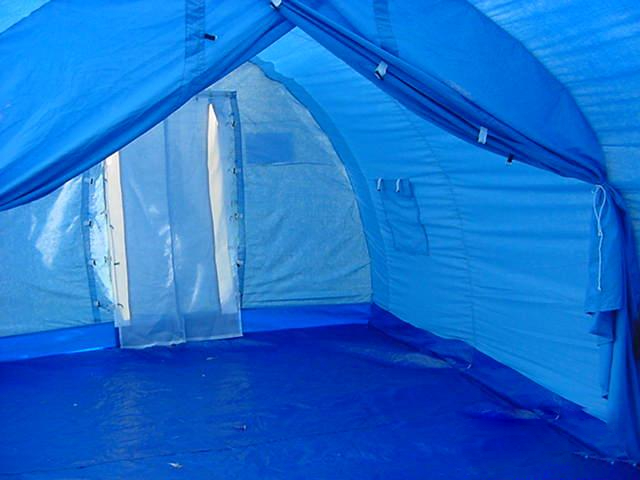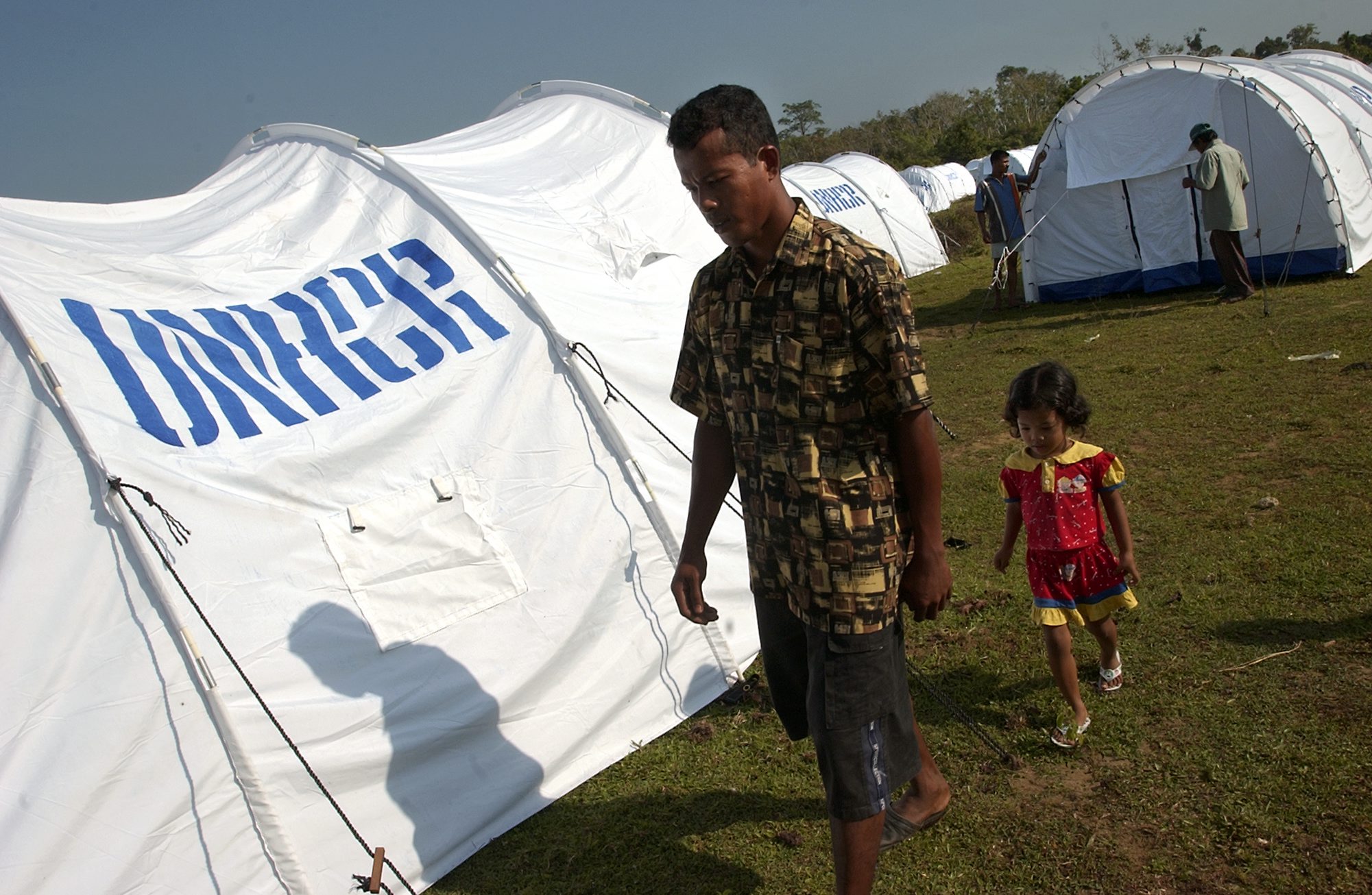
The UNHCR’s new Lightweight Emergency Tents in use in Meulaboh, West Sumatra, following the Indian Ocean tsunami of 2004 T. Pengilley/UNHCR
| Location | Various |
| Date | 2002-present |
| Organization | Office of the United Nations High Commissioner for Refugees (UNHCR) |
| End Client | Refugees, internally displaced populations |
| Design Consultant | Ghassem Fardanesh |
| Manufacturer | H. Sheikh Noor-ud-Din & Sons (Pvt.) Limited, Lahore, Pakistan |
| Cost per unit | Approx. $100 |
| Area | 178 sq. ft./16.5 sq. m |
| Occupancy | 4–5 people |
| Dimensions | 18 x 9.8 x 6.9 ft./5.5 x 3 x 2.1 m |
| Weight | 91 lb./41.5 kg |
In war-torn countries and areas devastated by disaster, the presence of UNHCR tents is one of the first signs of aid.
Designers have tried to rethink this basic tent for decades. Everything from prefabricated structures to shipping containers to polyurethane yurts has been suggested or attempted. But as the agency politely points out in its guide to emergency materials, to date none of these systems has proven effective in refugee situations. Most fail simply because other emergency shelter arrangements will have been made before these systems even arrive. Some tent alternatives are perceived as “too permanent,” making them difficult to site in host communities and creating less incentive for a refugee to return home. Others are difficult or costly to replicate.
But in recent years there has been a growing sense within the agency that the design of the standard family tent could and should be radically overhauled. In most emergencies the agency sends out plastic sheeting first. Depending on the size and complexity of the crisis, this sheeting may be the response of first and last resort. However, in cases where local materials are not available to build more permanent structures, where families cannot find shelter within the community or are displaced for longer periods of time, the UNHCR provides more durable alternatives — typically a ridge-style or center-pole-double-fly tent made from canvas. Yet these canvas tents are not only heavy, cumbersome to carry, and costly to ship, but because canvas rots they deteriorate quickly and cannot be stockpiled for long periods. Wear and tear on the weakened material in the field significantly shortens the useful lifespan of the shelter.



Left image: Standard UNHCR canvas tents shelter Sudanese refugees in Eastern Chad in 2004. If stockpiled for too long the canvas rots, shortening the useful lifespan of the tent in the field. H. Caux/UNHCR
Above right image: The Lightweight Emergency Tent in use in Meulaboh, West Sumatra, after the Indian Ocean tsunami of 2004. The tents are arranged at an angle to prevent those in facing tents from being able to see inside when the flaps are opened. G. Fardanesh/UNHCR
Below right image: Cumbersome canvas tents required as many as four people to carry. A man transports the new design on the back of a bicycle in Kreung Sabe, Indonesia. G. Fardanesh/UNHCR
In 2002 the UNHCR began testing a new design for the basic family tent it regularly dispatched to areas of crisis. The agency’s technical support, supply management, and emergency and security divisions developed specifications over the course of several years. The tent needed to be lightweight, durable, and have a longer shelf life than its canvas precursors. But because tents can cost as much to ship as to make, the primary consideration was one of volume in terms of both weight and size. “We are talking in terms of 50,000 to 100,000 tents,” explained Ghassem Fardanesh, a physical planner in the UNHCR Technical Support Section who helped spearhead the project. “Even when we hit the right design, some of the specifications didn’t come easily.”
The resulting design employs a tunnel shape to maximize headroom and usable space. An inner tent with a “bathtub” liner provides insulation and flooring. Air circulates through vents and window flaps lined with mosquito netting to guard against malaria. Guy ropes at the front and back rather than the sides allow the tent to be spaced closer to other tents. Because it is made from synthetic materials, the tent can be stockpiled in greater quantities, and its smaller volume and weight (91 pounds [41.5 kg] compared with 176 to 242 pounds [80 to 110 kg] for traditional canvas versions) saves on shipping costs and allows for easier handling. It even comes in its own “handbag.”
The most innovative aspect of the design is its recognition of the need for privacy. In refugee camps a survival mentality combined with close quarters can be an explosive combination, often increasing the incidence of the physical abuse of women and children. To mitigate such violence, the designers created a fabric partition to divide the tent, creating a semiprivate space where women can change and parents can sleep away from children. The partition can also be used to create a semipublic workspace to care for the wounded or sell supplies.
The agency made an initial production run of 10,000 units, and the new design has since been field-tested in Chad (in response to the Darfur crisis) and in areas of Indonesia affected by the tsunami of December 2004. But it could be years before the lightweight model replaces the UNHCR’s traditional canvas tent. “In our business it’s really difficult to say, ‘I have something new, and let’s replace [the old version].’ The tent we have now has been under surveillance for 20 years. This is a newborn baby,” said Fardanesh, who considers the tent a work in progress and expects it will undergo a number of manufacturing tweaks and other modifications before it is fully adopted.
Specifications for the Lightweight Emergency Tent for the UNHCR’s traditional canvas tents are provided in UN Inter-Agency Procurement Services Office, “Emergency Relief Items Vol.1: Compendium of Generic Specifications,” United Nations Development Programme, May 2000, http://www.iapso.org.



The tent packs in a carrying case and can be easily erected. G. Fardanesh/UNHCR

The new tent’s partition affords refugees and displaced families a modicum of privacy. G. Fardanesh/UNHCR
“In our business it’s really difficult to say, ‘I have something new, and let’s replace [the old version].’ The tent we have now has been under surveillance for 20 years. This is a newborn baby.”
Ghassem Fardanesh, Senior Physical Planner, UNHCR
















READ OR LEAVE A COMMENT